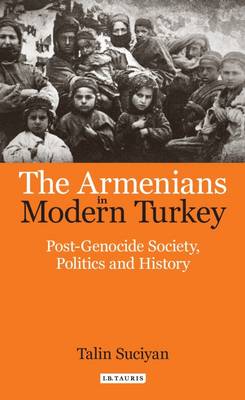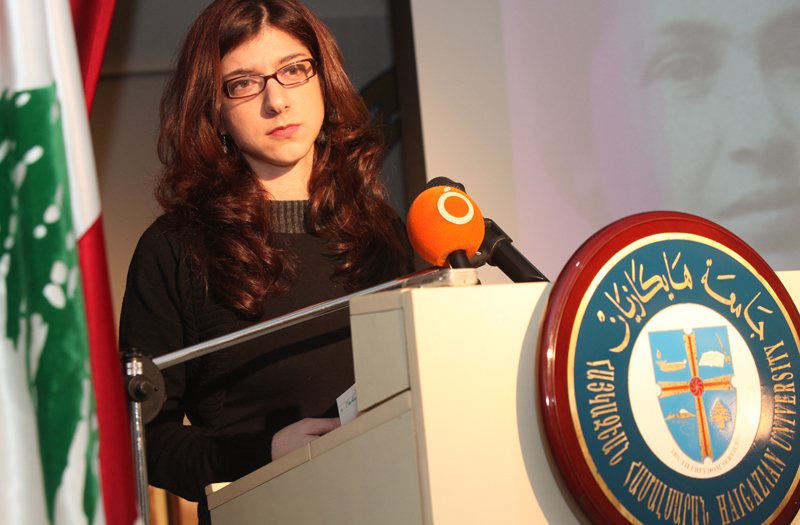Suciyan’s Book is an In-Depth Look into the Post-Genocide Armenian Community of Turkey
BELMONT, Mass. (A.W.)— Dr. Talin Suciyan, author of The Armenians in Modern Turkey: Post-Genocide Society, Politics, and History, presented a lecture covering some of the main themes in her book, as well as her research process, at the National Association for Armenian Studies and Research (NAASR) in Belmont earlier this year. Suciyan, who completed her Ph.D. at Ludwig Maximilian University (LMU) in Munich, is currently an assistant professor at the Institute of Near and Middle Eastern Studies at the same university. Below, we present key highlights from Suciyan’s illuminating talk, which took place on April 20.
In her opening remarks, NAASR Executive Director Sarah Ignatius welcomed guests and introduced attendees to Suciyan’s newly released and—what she called—“first of its kind” book, entitled The Armenians in Modern Turkey (I.B. Tauris, 2016). “What [Suciyan] was able to do in her book—for the first time—was to explore what life was like for Armenians living in Turkey, those who remained after the genocide, living in an environment of pervasive denial and among people who had been persecutors within the community. To conduct her research, she had access to primary source material in the Turkish State Archives, conducted oral histories, and utilized a variety of Armenian periodicals,” including memoirs both in Armenian and Turkish, and correspondence between patriarchs and Catholicosates, Ignatius said in her comments. She called Suciyan’s research “ground breaking.”
Suciyan presented an in-depth look into the post-genocide Armenian community of Turkey—the subject for her dissertation and book. She began her presentation by saying that the book was dedicated to the memory of Varujan Köseyan—an Edincik-born, Istanbul Armenian intellectual who dedicated most of his life to the Armenian press in Istanbul. Suciyan said that Köseyan was instrumental in storing and organizing numerous Armenian periodicals, which greatly helped her research.
“In his 80s, [Köseyan] moved to the [Surp Pırgiç] Armenian hospital’s elderly home until his death in 2011. While he was there, he witnessed Armenian periodicals being sent for recycling. At that moment, he intervened and succeeded in putting all these periodicals in a room where he stored them for years,” she said, adding that he was helpful in gaining access to the sources, which were previously not explored for academic research. Conditions in the facility housing the periodicals were not great during the time of her research. The room has since been renovated and reorganized into a proper library, Suciyan explained, noting that this was one of the most important achievements of her book. “Anyone who is interested in the history of Armenians should be grateful to him for putting that material together,” she said.
Suciyan explained that the official Turkish narrative pointed at the foundation of the modern republic in 1923 as a “zero-point,” and it maintained that the Ottoman past had nothing to do with “Turkish history.” “During my doctoral research, I realized that this narrative remained unchallenged for decades,” Suciyan said. She added that even today, fresh Ph.D. theses in the United States can be and are being written and published on the basis of this narrative. Needless to say, Turkish textbooks are not any different in this regard, she said.
Suciyan elaborated on Armenian life in the post-1923 period both in Istanbul and in the provinces of Turkey in the context of what she called the “post-genocide habitus of denial,” which consisted of official denial of the Armenian Genocide by the Turkish state, as well as social support provided to the practice and policy.
During her research, Suciyan began to question the conditions in which she was raised, and the family structures she was a part of as an Istanbul Armenian. “They were all embedded in denial—language, history, annihilation, survival, were all denied, at various levels. The abstraction that should have been made out of the catastrophic experiences and practices of a generation was left unrealized,” she said.
Suciyan described these catastrophic experiences and practices of the Armenians of Turkey: having families in which grandparents were killed; stories of kidnapping being normalized; knowing that relatives were converted from their faith; living with the notion that properties were lost through policies of confiscation. These notions—she went on to explain—furthered the norm of utilizing different names in different places, that is, at home and in public; having strange surnames issued under the surname law (1934); and living exclusively in districts and buildings in which only Armenians lived. “By utilizing all these strategies,” Suciyan explained, “one hides not only his or her identity, but also becomes invisible in the society at large, or visible—in fact, existent—in [his or her] own community alone,” and both spaces are defined by the denialist habitus, according to her.
Suciyan stressed that by using the term “post-genocide,” she intended to underline the continuity between the Ottoman Empire and the modern Turkish Republic in terms of denial, since the collective violence and the policies of the genocide period continued on for decades based on denial. “‘Post-genocide’ does not refer to a time period, but rather emphasizes the reservoir of experience and knowledge that has been attained through implementing genocidal policies and reproduced over decades, through mechanisms of denial,” she said.
During her research, Suciyan began to question the conditions in which she was raised, and the family structures she was a part of as an Istanbul Armenian. “They were all embedded in denial—language, history, annihilation, survival, were all denied, at various levels. The abstraction that should have been made out of the catastrophic experiences and practices of a generation was left unrealized,” she said.
She went on to explain that it is very important to understand that both survivors and perpetrators of the Armenian Genocide have lived side-by-side in Turkey for years, without any recognition of the crime, in an environment of denial. “This aimed at erasing the categories of ‘victim,’ ‘survivor,’ and ‘perpetrator,’ creating a set of practices in everyday life and normalizing the crime,” which Suciyan refers to as the “habitus of denial.”
“In this habitus of denial, the survivor continues to be victimized over generations, and the perpetrator remains exempt from responsibility. While the genocide creates an endless, irreversible, unaccountable, and indescribable situation for the victim and the survivor, the post-genocide period in Turkey has been normalizing all these by denial,” she said.
Suciyan explained how she used the Armenian periodicals of Turkey—including monthly and weekly magazines, almanacs, and various daily newspapers—as sources for her research. She also used books published by compatriotic unions across the Armenian Diaspora, from the 1930’s onwards. These books—which included volumes on the history of the Armenians of Aintab, Arapgir, Zeitun, Sepastia, and several other regions—were instrumental in her research and the research of others in the field.
“Although it is inspiring to see young scholars like Umit Kurt or Tolga Cora learning Western Armenian and working on these sources, we still have to question the silence regarding these sources for almost 100 years,” she said, arguing that historians of the Ottoman Empire—especially of the 19th and 20th centuries—and historians of post-1923 period need much more self-criticism regarding the structures and, at least, implicit strategies of their own knowledge production: the language skills that they obtain throughout their studies, the methodology they employ, the possibilities they offer to the young scholars who master languages other than Turkish, the sources they utilize, the way they contextualize them, the words, concepts, and terminologies they prefer to use, and even their social relations,” she explained.
She later presented some of the oral histories of several people across the world, who had lived in post-genocide Turkey.
Suciyan’s book also includes a chapter on the patriarchal election crisis [1944-1950], which she called an “international crisis that involved the Patriarchate of Istanbul, the Catholicosate of Etchmiadzin, the Catholicasate of Cilicia in Lebanon, the Prelacies in the U.S. and elsewhere and many communities around the world.” She explained that the details of the crisis—which are often referred to, but never written about—could be found in her book, since “church history—like the history of the community—is a social and political one,” especially since the Armenian Apostolic Church remained in the center of communal organization for hundreds of years. “A social history of the Armenians of Turkey in the mid-20th century ignoring the crisis could not have been written,” Suciyan said.
In her conclusion, Suciyan said that the denial of the Armenian Genocide has been systematically institutionalized and socially reproduced in Turkey. “In the book, I tried to show the dynamics of surviving in the geography of genocide. You will see that despite institutionalized and normalized denial, and despite the fact that Armenians were forced to be part of the denial as a consequence of their survival, Armenian intellectuals of the first generation of the Republican years struggled consistently against denial and inequality. They continued their claims of rights, they protested against anti-Armenian campaigns, and against the eradication of the legal basis of their community, and racism in general. The result of this struggle devastated their lives. Nonetheless, their struggle should find its due place in historiography,” she said.
Following her lecture, those present were given the opportunity to ask Suciyan questions regarding her presentation and her book, in a question-and-answer session moderated by NAASR Director of Academic Affairs Marc Mamigonian.
Source: Armenian Weekly
Link: Dr. Talin Suciyan’s ‘The Armenians in Modern Turkey’ Breaks New Ground


